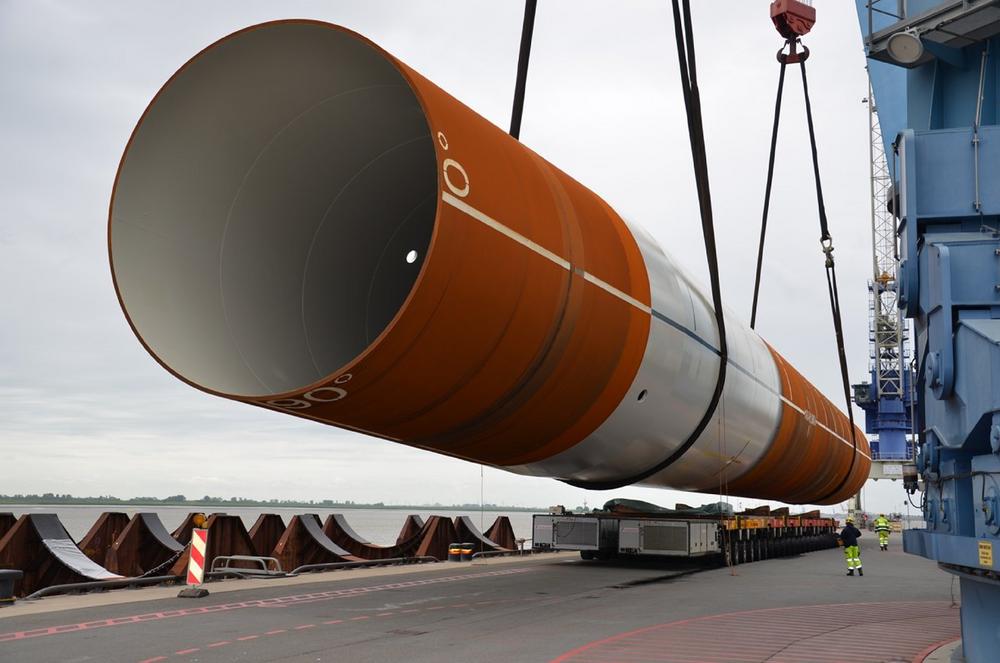Producing the huge steel pipes for offshore wind farms requires heavy plate like that produced by the steel company Dillinger in Saarland. The plates, with wall thickness of about ten centimeters, are welded together to form pipe sections with diameters of up to ten meters. These are then joined piece by piece with additional welding seams to lengths totaling more than 80 meters. “The key issue with this process is the intense heat that is briefly applied to the steel at the weld and that changes the internal structure of the material. The thicker the heavy plates are and the faster they are welded together under production conditions, the more drastic the deviations can be in the structure around the welding seams,” explained Frank Mücklich, Professor of Functional Materials at the University of Saarland.
The materials researcher and his team have developed special analytical techniques that can be used to quantitatively represent all changes in this internal structure of materials. The researcher uses high-resolution electron and ion microscopes for this, ranging up to nanotomography and atom probe tomography. Information and image sequences acquired at various scales in this process are then reassembled in the computer to form a precise spatial image of the steel structure – down to the individual atom. “This enables us to see at the micro and nano levels, as well as at the atomic scale, what fine adjustments need to be made to modify a material so that it has the desired properties,” said Frank Mücklich, who also heads the Steinbeis Research Center for Materials Engineering at the university campus in Saarbrücken.
The project partners are now working together with monopile producers EEW Special Pipe Constructions, the Sif Group, and the welding consumables and power source manufacturer Lincoln Electric to further optimize the steel of the heavy plate for the welding processes used in constructing offshore wind turbines.
“Dillinger has made forward-looking investments and has spurred on innovation in recent years to develop advanced sheet metal for the demanding monopile market,” said Sebastian Scholl of Dillinger, who holds a doctorate in materials science and is a welding engineer. As a result, Dillinger has already been able to significantly boost productivity and has helped reduce construction costs for offshore wind turbines. Scholl added that it is also important to further increase the efficiency of heavy fabrication processing, such as by increasing the maximum welding speed that can be achieved with Dillinger’s steel grades. Modern welding processes for heavy plate, including multi-wire submerged arc welding or electron beam welding, play an important role here. “The next important step will be to reduce the production time.
This can be achieved with high-performance welding methods. We therefore want to work together with our partners in this research project to develop a steel that meets these high demands,” Scholl said. Professor Uwe Reisgen, head of the RWTH Institute of Welding and Joining Technology, agrees: “Enormous steel structures like these are absolutely inconceivable without welding technology. For the enormous quantities involved, we need both highly efficient welding processes and custom-tailored materials. They have to be easy to process using high-performance welding methods, without losing their mechanical-technological properties. I’m very pleased that a highly competent steel company like Dillinger wants to follow this path together with us.”
The German Ministry of Economic Affairs and Energy is funding the joint project with EUR 1.2 million as part of the “Innovations for the energy transition” energy research program. The research project has a total financial volume of more than EUR 1.9 million. “We want to contribute with this project not only to further developing renewable energies but also to securing production sites in Germany and Europe,” materials researcher Frank Mücklich said.
For more information:
https://www.fuwe.uni-saarland.de (Department of Functional Materials)
http://www.mec-s.de (Steinbeis Research Center for Material Engineering)
https://www.isf.rwth-aachen.de (RWTH Aachen University)
https://www.dillinger.de (Dillinger)
https://eew-group.com (EEW Special Pipe Constructions)
https://www.sif-group.com (Sif Group)
https://www.lincolnelectric.com (Lincoln Electric)
AG der Dillinger Hüttenwerke
Werkstraße 1
66763 Dillingen/Saar
Telefon: +49 (6831) 47-0
Telefax: +49 (6831) 47-2212
http://www.dillinger.de/
Telefon: +49 (6898) 10-2234
E-Mail: juliane.wernet@stahl-holding-saar.de
RWTH Aachen University, Institute for Welding and Joining Technology
Telefon: +49 (241) 80-93870
E-Mail: head@isf.rwth-aachen.de
Presse- & Öffentlichkeitsarbeit
Telefon: +49 (6831) 47-3011
Fax: +49 (6831) 47-3331
E-Mail: ute.engel@stahl-holding-saar.de
![]()
